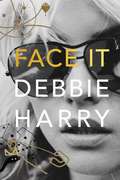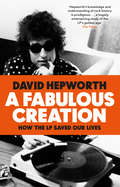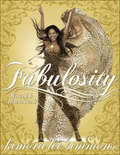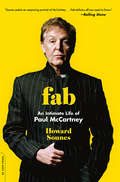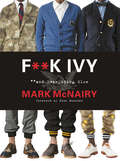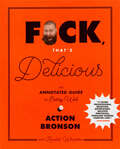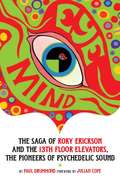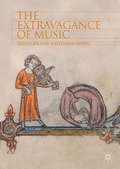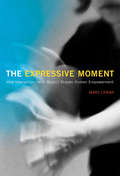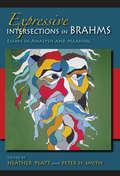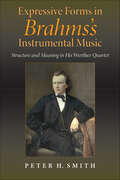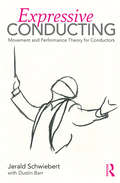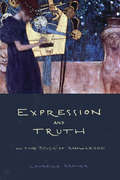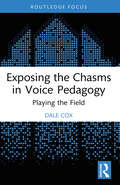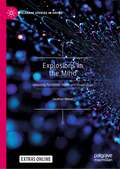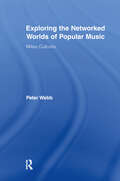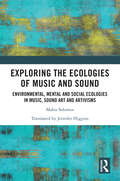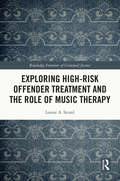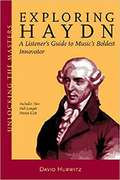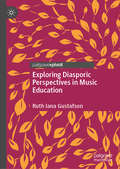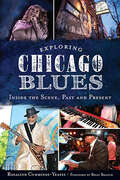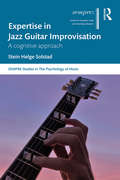- Table View
- List View
Face It
by Debbie HarryMusician, actor, activist, and the iconic face of New York City cool, Debbie Harry is the frontwoman of Blondie, a band that forged a new sound that brought together the worlds of rock, punk, disco, reggae and hip-hop to create some of the most beloved pop songs of all time. As a muse, she collaborated with some of the boldest artists of the past four decades. The scope of Debbie Harry's impact on our culture has been matched only by her reticence to reveal her rich inner life--until now. <p><p> In an arresting mix of visceral, soulful storytelling and stunning visuals, Face It upends the standard music memoir while delivering a truly prismatic portrait. With all the grit, grime, and glory recounted in intimate detail, Face It re-creates the downtown scene of 1970s New York City, where Blondie played alongside the Ramones, Television, Talking Heads, Iggy Pop and David Bowie. Aesthetically dazzling, and including never-before-seen photographs, bespoke illustrations and fan art installations, Face It brings Debbie Harry's world and artistic sensibilities to life. <p> Following her path from glorious commercial success to heroin addiction, the near-death of partner Chris Stein, a heart-wrenching bankruptcy, and Blondie's breakup as a band to her multifaceted acting career in more than thirty films, a stunning solo career and the triumphant return of her band, and her tireless advocacy for the environment and LGBTQ rights, Face It is a cinematic story of a woman who made her own path, and set the standard for a generation of artists who followed in her footsteps--a memoir as dynamic as its subject.
A Fabulous Creation: How the LP Saved Our Lives
by David Hepworth_________‘Hepworth’s knowledge and understanding of rock history is prodigious … [a] hugely entertaining study of the LP’s golden age’ The Times_________The era of the LP began in 1967, with ‘Sgt Pepper’; The Beatles didn’t just collect together a bunch of songs, they Made An Album. Henceforth, everybody else wanted to Make An Album. The end came only fifteen years later, coinciding with the release of Michael Jackson’s ‘Thriller’. By then the Walkman had taken music out of the home and into the streets and the record business had begun trying to reverse-engineer the creative process in order to make big money. Nobody would play music or listen to it in quite the same way ever again.It was a short but transformative time. Musicians became ‘artists’ and we, the people, patrons of the arts. The LP itself had been a mark of sophistication, a measure of wealth, an instrument of education, a poster saying things you dare not say yourself, a means of attracting the opposite sex, and, for many, the single most desirable object in their lives.This is the story of that time; it takes us from recording studios where musicians were doing things that had never been done before to the sparsely furnished apartments where their efforts would be received like visitations from a higher power. This is the story of how LPs saved our lives.
Fabulosity: What It Is & How to Get It
by Kimora Lee SimmonsFabulosity (n): 1: a state of everything that is fabulous 2: a quality ascribed to that which expresses glamour, style, charisma, power, and heartKimora Lee Simmons knows what it means to have fabulosity -- and she wants to tell you how to get it.In this empowering new book, Kimora -- a top model, wife of hip-hop legend Russell Simmons, mother to two daughters, a national media presence, and president and creative director of the multimillion-dollar Baby Phat company -- shares her personal secrets of success and fabulosity.Kimora knows that in today’s ultracompetitive world, it’s not enough for women just to be smart or dress well. With too much to do and competition everywhere, the savvy woman must know how to combine feminine glamour with professional power, business ambition with personal values, and confidence with heart. Kimora is the living picture of all these things. What are Kimora’s secrets to achieving her goals, her signature fabulosity? One is her ability to identify and build upon her own unique talents and strengths. In Kimora’s case, she brilliantly combined the two worlds she knows best -- the high fashion and hip-hop scenes -- to create Baby Phat, her ultrasuccessful hip-hop inspired lifestyle brand.How do you uncover and develop your own special talents? Kimora shares her step-by-step guide to achieving your wildest dreams, including her 16 laws of success, which cover everything you need to become the woman you want to be.Whether you’re college-educated or street smart, just starting out or at the top of your game, Fabulosity has something to say to you. Learn how to cultivate Power, Independence, Confidence, and Positivity in everything you do, whether it’s finding Mr. Right, snagging that corner office, or rocking the latest fashion trend. Packed with useful lessons and Kimora’s personal tips, this book will be your instruction manual to empowering yourself, turning your individual talents into permanent success, and unleashing your inner fabulosity.
FAB An Intimate Life of Paul McCartney: An Intimate Life of Paul McCartney
by Howard SounesAuthor of an exceptionally good biography of Bob Dylan, Sounes doesn't fare quite as well with this substantial volume on the life of Paul McCartney. While the author has obviously done his research, there's relatively little new of significance here, other than some details on McCartney's relationships. Unfortunately for the author, those who could have shed more light on McCartney as a musician and songwriter are either not talking (Ringo Starr) or unavailable for comment (John Lennon, George Harrison). While there is little (other than page count) to make Sounes' book stand apart from other recent McCartney bios, the author's lively style makes his book an interesting read. Published in the U. K. and Australia by HarperCollins 2010. Annotation ©2011 Book News, Inc. , Portland, OR (booknews. com)
F--k Ivy and Everything Else
by Mark McnairyThe renowned designer's views on dressing and behaving well: Ivy League meets street, sartorial rules are made and broken in this must-have style guide for traditionalists and hipsters alike, filled with Mark McNairy's humorous, sometimes snarky, spot-on observations. With a Foreword by Nick Wooster.Supported by a powerful cult following of dedicated, fashion-forward men around the globe, designer Mark McNairy has risen from an under-the-radar favorite to a driving force in contemporary style. His collection of menswear and footwear, Mark McNairy New Amsterdam, is defined by a strong sense of sartorial history with an eye fixed on the future; a unique style that reflects the designer's vast knowledge of American and English tailoring tradition and complete dedication to craftsmanship and his insistence upon messing it up a bit.With McNairy, irreverence rules, and in this definitive book, his fresh take on traditional menswear is displayed in full force. At once a style guide that provides invaluable tips for today's men, it is also, like his clothing and accessories, a witty riff on the Ivy League look.Showcasing a mix of vintage fashion and film images that reference traditional menswear and style icons like Steve McQueen and Clint Eastwood; examples of streetwear and McNairy's clothing; and advertising and pop culture references, F--k Ivy and Everything Else is a visual treat from spread to spread, packed with solid sartorial advice and cheeky humor.
F*ck, That's Delicious: An Annotated Guide to Eating Well
by Action Bronson Rachel WhartonThe rapper, chef, TV star, and author of Stoned Beyond Belief offers up a love letter to food inspired by his childhood, family, tours, and travels.This ain’t no cookbook. This ain’t no memoir. This is Action Bronson’s devotional, a book about the overwhelming power of delicious—no, f*cking amazing—food. Bronson is this era’s Homer, and F*ck, That’s Delicious is a modern-day Odyssey, replete with orgiastic recipes, world travel, siren songs, and weed. Illustrated, packed with images, and unlike any book in the entire galaxy, Bronson’s F*ck, That’s Delicious includes forty-plus recipes inspired by his childhood, family, tours, and travels. Journey from bagels with cheese that represent familial love to the sex and Big Macs of upstate New York fat camp and ultimately to the world’s most coveted five-star temples of gastronomy. And: the tacos in LA. The best Dominican chimis. Jamaican jerk. Hand-rolled pasta from Mario. Secrets to good eating from Massimo. Meyhem Lauren’s Chicken Patty Potpie. And more! more! more!New York Times BestsellerWinner of the IACP Cookbook Design Award“This magnificent tome is filled with both the recognizable and the perplexing. And, best of all, I can make it at home and so can you. . . . This is a book that is at once a testament to a wild palate, to a man with a gastronomic vision, to a hip-hop artist of the top of the top category, and a student of life with legendary curiosity.” —Mario Batali, from the foreword“Through his career on VICELAND, Bronson has become one of the Internet’s most entertaining food personalities—and his book delivers just as much loud enthusiasm for eating fucking delicious things as his show by the same name.” —GQ magazine
Ezio Pinza: An Autobiography
by Ezio Pinza Robert Magidoff Doris PinzaThe bass, Ezio Pinza (1892-1957) gives an account of his childhood in Italy, arrival in the United States, his opera career at the Met from 1926 to 1948, and his Broadway success co-starring with Mary Martin in Rodgers and Hammerstein's South Pacific. He sang many opera roles but was especially noted for Don Giovanni, Mozart's Figaro and Boris Godunov. Some of his recordings are still available on CD.
Eye Mind
by Paul Drummond Julian Cope"One of the most exhilarating and important rock 'n' roll stories ever told."--Julian CopeThe trailblazing 13th Floor Elevators released the first "psychedelic" rock album in America, transforming culture throughout the 1960s and beyond. The Elevators followed their own spiritual cosmic agenda, to change society by finding a new path to enlightenment. Their battles with repressive authorities in Texas and their escape to San Francisco's embryonic counterculture are legendary.When the Elevators returned to Texas, the band became subject to investigation by Austin police. Lead singer Roky Erickson was forced into a real-life enactment of One Flew over the Cuckoo's Nest and was put away in a maximum-security unit for the criminally insane for years. Tommy Hall, their Svengali lyricist, lived in a cave. Guitarist Stacy Sutherland was imprisoned. The drummer was involuntarily subjected to electric shock treatments, and the bassist was drafted into the Vietnam War.This fascinating biography breaks decades of silence of band members and addresses a huge cult following of Elevators fans in the United States and Europe. The group is revered as a formative influence on Janis Joplin, Led Zeppelin, Patti Smith, Primal Scream, R.E.M, and Z.Z. Top.Roky Erickson is the subject of a heralded recent documentary feature, You're Gonna Miss Me; a box set of remastered Elevators CDs with liner notes by author Paul Drummond will be issued in fall 2007.
The Extravagance of Music
by David Brown Gavin HoppsThis book explores the ways in which music can engender religious experience, by virtue of its ability to evoke the ineffable and affect how the world is open to us. Arguing against approaches that limit the religious significance of music to an illustrative function, The Extravagance of Music sets out a more expansive and optimistic vision, which suggests that there is an ‘excess’ or ‘extravagance’ in both music and the divine that can open up revelatory and transformative possibilities. In Part I, David Brown argues that even in the absence of words, classical instrumental music can disclose something of the divine nature that allows us to speak of an experience analogous to contemplative prayer. In Part II, Gavin Hopps contends that, far from being a wasteland of mind-closing triviality, popular music frequently aspires to elicit the imaginative engagement of the listener and is capable of evoking intimations of transcendence. Filled with fresh and accessible discussions of diverse examples and forms of music, this ground-breaking book affirms the disclosive and affective capacities of music, and shows how it can help to awaken, vivify, and sustain a sense of the divine in everyday life.
The Expressive Moment: How Interaction (with Music) Shapes Human Empowerment
by Marc LemanA new way to understand expressive interaction, focusing on the dynamic, fast, pre-reflective processes underlying interactions with music.The expressive moment is that point in time when we grasp a situation and respond quickly, even before we are aware of it. In this book, Marc Leman argues that expression drives this kind of interaction, and he proposes a general framework for understanding expressive interactions. He focuses on the dynamic, fast, and pre-reflective processes underlying our interactions with music—whether we are playing an instrument, dancing, listening, or using new interactive technologies. Music offers a well-established domain for studying these fast and interactive processes, and Leman argues that understanding the power of expressive interaction through music may help us understand cognitive processing in other domains, including language, human action coordination, human-animal interaction, and human-machine interaction.Leman regards expressive interactions with music as energizing and empowering. He argues that music is based on patterns that intervene with a reinforcing loop in the human brain, strengthening learning, motivation, and reward. He argues further that the reinforcing effect is influenced by the interaction flow, by fast processes that handle expressive qualities on the fly.Leman sets out the framework in which expressive interaction is situated, describing, among other things, a pragmatic model of communication in which the fundamental components are enactment and dynamics. He looks in more detail at the cognitive-motivational architecture, discussing sensorimotor and motivational schemes. Finally, he discusses applications for the concepts behind expressive motivation in such fields as sports, entertainment, rehabilitation, multimedia art, and music education.
Expressive Intersections in Brahms: Essays in Analysis and Meaning (Musical Meaning And Interpretation Ser.)
by Heather Platt and Peter H. Smith&“This exceptionally fine collection brings together many of the best analysts of Brahms, and nineteenth-century music generally, in the English-speaking world today.&” —Nineteenth-Century Music Review Contributors to this exciting volume examine the intersection of structure and meaning in Brahms&’s music, utilizing a wide range of approaches, from the theories of Schenker to the most recent analytical techniques. They combine various viewpoints with the semiotic-based approaches of Robert Hatten, and address many of the most important genres in which Brahms composed. The essays reveal the expressive power of a work through the comparison of specific passages in one piece to similar works and through other artistic realms such as literature and painting. The result of this intertextual re-framing is a new awareness of the meaningfulness of even Brahms&’s most &“absolute&” works. &“Through its unique combination of historical narrative, expressive content, and technical analytical approaches, the essays in Expressive Intersections in Brahms will have a profound impact on the current scholarly discourse surrounding Brahms analysis.&” —Notes
Expressive Forms in Brahms's Instrumental Music: Structure and Meaning in His Werther Quartet (Musical Meaning and Interpretation)
by Peter H. Smith"This book is a substantial and timely contribution to Brahms studies. Its strategy is to focus on a single critical work, the C-Minor Piano Quartet, analyzing and interpreting it in great detail, but also using it as a stepping-stone to connect it to other central Brahms works in order to reach a new understanding of the composer's technical language and expressive intent. It is an original and worthy contribution on the music of a major composer." —Patrick McCrelessExpressive Forms in Brahms's Instrumental Music integrates a wide variety of analytical methods into a broader study of theoretical approaches, using a single work by Brahms as a case study. On the basis of his findings, Smith considers how Brahms's approach in this piano quartet informs analyses of similar works by Brahms as well as by Beethoven and Mozart.Musical Meaning and Interpretation—Robert S. Hatten, editor
Expressive Conducting: Movement and Performance Theory for Conductors
by Jerald Schwiebert Dustin BarrExpressive Conducting: Movement and Performance Theory for Conductors applies the insight of movement and performance theory to the practice of conducting, offering a groundbreaking new approach to conducting. Where traditional conducting pedagogies often place emphasis on training parts of the body in isolation, Expressive Conducting teaches conductors to understand their gestures as part of an interconnected system that incorporates the whole body. Rather than emphasizing learning specific patterns and gestures, this book enables student and professional conductors to develop a conducting technique that is centered around expressing the themes of the music. Drawing parallels to the worlds of acting, this text treats the body as the conductor’s instrument. Coaching notes derived from years of experience as a performance movement specialist offer readers approachable methods for eliminating communication barriers—both conscious and subconscious—to encourage optimal performance, highlighting acting theory, movement exercises and the significance of weight distribution. Unlike other conducting approaches, this text understands that conducting resonates throughout the entire body and is not conveyed by the hands or baton alone. With a comprehensive consideration of the conductor’s body and movements, featuring over 50 original illustrations, Expressive Conducting advances strategies for improving one’s conducting skills in rehearsal and performance. Jerald Schwiebert has developed a practical language for expressive conducting. Together, Schwiebert and Barr present a text that is suitable for conducting students, instructors, and professionals alike.
Expression and Truth
by Lawrence KramerExpression and truth are traditional opposites in Western thought: expression supposedly refers to states of mind, truth to states of affairs. Expression and Truth rejects this opposition and proposes fluid new models of expression, truth, and knowledge with broad application to the humanities. These models derive from five theses that connect expression to description, cognition, the presence and absence of speech, and the conjunction of address and reply. The theses are linked by a concentration on musical expression, regarded as the ideal case of expression in general, and by fresh readings of Ludwig Wittgenstein's scattered but important remarks about music. The result is a new conception of expression as a primary means of knowing, acting on, and forming the world. "Recent years have seen the return of the claim that music's power resides in its ineffability. In Expression and Truth, Lawrence Kramer presents his most elaborate response to this claim. Drawing on philosophers such as Wittgenstein and on close analyses of nineteenth-century compositions, Kramer demonstrates how music operates as a medium for articulating cultural meanings and that music matters too profoundly to be cordoned off from the kinds of critical readings typically brought to the other arts. A tour-de-force by one of musicology's most influential thinkers."--Susan McClary, Desire and Pleasure in Seventeenth-Century Music.
Exposing the Chasms in Voice Pedagogy: Playing the Field
by Dale CoxThis concise book critically examines the intersection of power, privilege, and classical music in higher education through an extensive study of the experiences, training, and background of teachers of musical theatre singing.Mapping the divides within the voice pedagogy field, it shows how despite the growth of non-classical programmes, the teaching of vocal music in the United States continues to be structurally dominated by Western classical music. Drawing on extensive fieldwork and observations of practicing instructors, the author argues that current voice pedagogy training’s classical-centred approach fails to prepare instructors to teach the range of vocal styles needed in the contemporary musical theatre profession. Combining a critical review of existing practices with proposals for change, this book sheds light on a key problem in voice pedagogy today.Based on field research and drawing on both Shulman’s signature pedagogies theory and Bourdieu’s concepts of habitus, capitals, practice, and field, this book will be useful for scholars, researchers, and practitioners of voice pedagogy, higher music education, performance education, cultural studies, music, musical theatre, and theatre studies.
Explosions in the Mind: Composing Psychedelic Sounds and Visualisations (Palgrave Studies in Sound)
by Jonathan WeinelThis book explores how to compose sounds and visualisations that represent psychedelic hallucinations and experiences of synaesthesia. Through a detailed discussion regarding compositional methodologies and technical approaches, the book aims to educate students, practitioners, and researchers working in related areas. It weaves together sound, visual design, and code across a range of media, providing conceptual approaches, theoretical insights, and practical strategies, which unlock new design frameworks for composing psychedelic sounds and visualisations.
Exploring the World of J. S. Bach: A Traveler's Guide
by Traute M. Marshall Robert L. MarshallA singular resource, Exploring the World of J. S. Bach puts Bach aficionados and classical music lovers in the shoes of the master composer. Bach scholar Robert L. Marshall and veteran writer-translator Traute M. Marshall lead readers on a Baroque Era odyssey through fifty towns where Bach resided, visited, and of course created his works. Drawing on established sources as well as newly available East German archives, the authors describe each site in Bach's time and the present, linking the sites to the biographical information, artistic and historic landmarks, and musical activities associated with each. A wealth of historical illustrations, color photographs, and maps supplement the text, whetting the appetite of the visitor and the armchair traveler alike.
Exploring the Networked Worlds of Popular Music: Milieux Cultures (Routledge Advances in Sociology)
by Peter WebbThis book provides an `insider’ view of worlds of popular music. It shows the relationship between music, creativity, ideas and localities by looking at cities, independents, genre, globalization and musician’s relationships with each other. Webb examines groups of musicians, audiences and people involved in the music industry and shows the articulation of their position as well as how to understand this theoretically by looking at the city as a centre for music production; the industrial music inspired neo-folk genre; independence and its various meanings as a productive position in the music industry; the globalization of music; and musicians own narratives about working together and dealing with the industry. Utilizing case studies of a variety of different cities -- Bristol, London, New York, San Francisco, Berlin -- and genres -- Trip-hop, Hip-hop, Industrial, Neo-folk -- this volume is a landmark in popular music studies.
Exploring the Ecologies of Music and Sound: Environmental, Mental and Social Ecologies in Music, Sound Art and Artivisms
by Makis SolomosMakis Solomos explores the ecologies of music and sound, inspired by Felix Guattari, for whom environmental destruction caused by capitalism goes hand in hand with deteriorating ways of living and feeling, and for whom an ecosophical stance, combining various ecological registers, offers a glimpse of emancipation, a position strengthened today by intersectional approaches. Solomos explores environmental, mental and social ecologies through the lens of the history of music and current artivisms – especially in the fields of acoustic ecology, contemporary music and sound art. Several theoretical and analytical debates are put forward, including a theory of sound milieus and the biopolitics of sound; the relationships between music and the living world; soundscape compositions, field recording, ecomusicology, and the creation of sound biotopes; the use of sound and music to violent ends as well as considering the social and political functions of music and the autonomy of art, sonic ecofeminism, degrowth in music, and much more.
Exploring High-risk Offender Treatment and the Role of Music Therapy (Routledge Frontiers of Criminal Justice)
by Louise A. SicardExploring High-risk Offender Treatment and the Role of Music Therapy explores the treatment delivered to high-risk offenders with complex needs, focusing on sex and violent offenders. The book advocates for the further use of less traditional and creative therapies, in particular, music therapy. The higher the risk, the greater the needs. Offenders with complex needs have a range of factors impacting their abilities and well-being including mental health and learning disorders. Importantly, high-risk offenders commonly present with complex needs and, therefore, require treatment that is highly responsive. Guiding this book is the existing literature and qualitative research, conducted by the author, that sought to gain the perspectives and experiences of practitioners in the field. This included 38 interviews with those that deliver treatment to high-risk offenders and music therapy. This book examines the components of high-risk offender treatment, highlighting the effective elements and the limitations found within the literature and from the perspective of interviewed practitioners. Offering insight into less traditional therapies, the book presents literature surrounding mindfulness, psychodrama and art therapy for high-risk offenders. It is argued that there has been a recent shift towards a creative corrections approach, where less traditional therapies are gaining recognition within offender treatment, as they offer unique and supportive benefits to traditional treatment. This book focuses on examining the role of music therapy for high-risk offenders, mainly through a critical discussion on the relevant literature and qualitative practitioner data. Advocating the further implementation of creative corrections approaches, this book will be of great interest to academics and researchers within the fields of offender treatment and penology, as well as forensic psychologists and those studying or practicing music therapy.
Exploring Haydn: A Listener's Guide to Music's Boldest Innovator (Unlocking the Masters #6)
by David HurwitzNo composer has ever achieved the amazing progression that Haydn has. He invented the string quartet as we know it today, became “the Father of the Symphony ” and founded the greatest school in the history of music. His life was one of ceaseless experimentation and invention, of problems surmounted and challenges met. In this book, No. 6 in the Amadeus Press Unlocking the Masters series, David Hurwitz acquaints readers with Haydn's innovative melodic creativity, his revolutionary use of musical form, and important characteristics of his personal style, including his genius for writing in minor keys and creating comedy in his music. In addition to Haydn's principal instrumental works, Hurwitz explores Haydn's vocal music and instrumental masterpieces that fall outside the mainstream. Four appendixes list all of his symphonies, string quartets, piano sonatas, and piano trios. Over two and a half hours of music keyed to pieces described in the book are available online using the unique code in each book.
Exploring Diasporic Perspectives in Music Education
by Ruth Iana GustafsonThis book challenges simplified claims of racial, national, and ethnic belonging in music education by presenting diaspora as a new paradigm for teaching music, departing from the standard multicultural guides and offering the idea of unfinished identities for musical creations. While multiculturalism—the term most commonly used in music education—had promised a theoretical framework that puts classical, folk, and popular music around the world on equal footing, it has perpetuated the values of Western aesthetics and their singular historical development. Breaking away from this standard, the book illuminates a diasporic web of music’s historical pathways, avoiding the fragmentation of music by categories of presumed origins whether racial, ethnic, or national.
Exploring Chicago Blues: Inside the Scene, Past and Present (Music Ser.)
by Rosalind Cummings-YeatesDiscover the living legacy of Chicago Blues in this guide to the iconic clubs and musicians who made—and keep making—music history.During the Great Migration, African Americans left Mississippi for Chicago, and they brought their music traditions with them. The music took root in the city and developed its own distinctive sound. Today, Chicago Blues is heard all over the world, but there&’s no better place to experience it than in the city where it was born. In Exploring Chicago Blues, Chicago music writer Rosalind Cummings-Yeates takes you inside historic blues clubs like the Checkerboard Lounge and Gerri's Palm Tavern, where folks like Muddy Waters, Howlin' Wolf, Willie Dixon and Ma Rainey transformed Chicago into the blues mecca. She then takes you on an insider&’s tour of the contemporary blues scene, introducing the best spots to hear the purest sounds of Sweet Home Chicago.
Exploring Bach's B-minor Mass
by Yo Tomita Robin A. Leaver Jan Smaczny Yo Tomita Robin A. LeaverThe B-minor Mass has always represented a fascinating challenge to musical scholarship. Composed over the course of Johann Sebastian Bach's life, it is considered by many to be the composer's greatest and most complex work. The fourteen essays assembled in this volume originate from the International Symposium 'Understanding Bach's B-minor mass' at which scholars from eighteen countries gathered to debate the latest topics in the field. In revised and updated form, they comprise a thorough and systematic study of Bach's Opus Ultimum, including a wide range of discussions relating to the Mass's historical background and contexts, structure and proportion, sources and editions, and the reception of the work in the late eighteenth and early nineteenth centuries. In the light of important new developments in the study of the piece, this collection demonstrates the innovation and rigour for which Bach scholarship has become known.
Expertise in Jazz Guitar Improvisation: A Cognitive Approach (SEMPRE Studies in The Psychology of Music)
by Stein Helge SolstadExpertise in Jazz Guitar Improvisation is an examination of musical interplay and the ways implicit (sub-conscious) and explicit (conscious) knowledge appear during improvisation. The practice-based research inquiry includes: interviews and interplay with five world-class jazz guitarists, Lage Lund, Jack Wilkins, Ben Monder, Rez Abbasi and Adam Rogers; a modal matrix for analyzing structure, time and form in jazz guitar improvisation, and musical analysis based on cognitive theories. By explaining the cognitive and musical foundations for expertise in jazz guitar improvisation, this book illuminates how jazz guitarists' strategies are crucially dependent on context, style and type of interplay. With accompanying video provided as an e-resource, this material will be of interest to anyone fascinated by Jazz and Psychology of Music.
